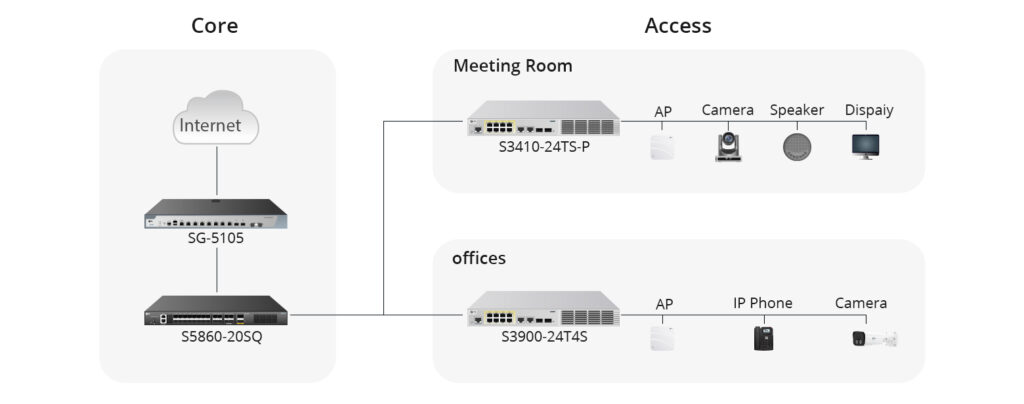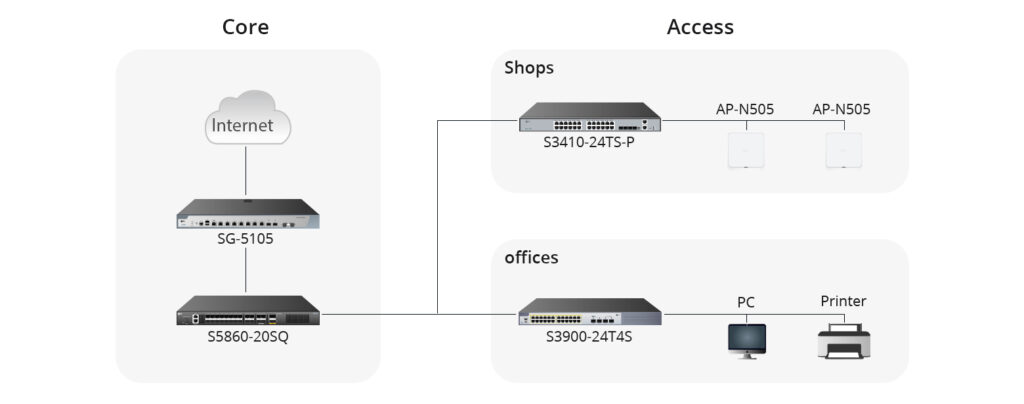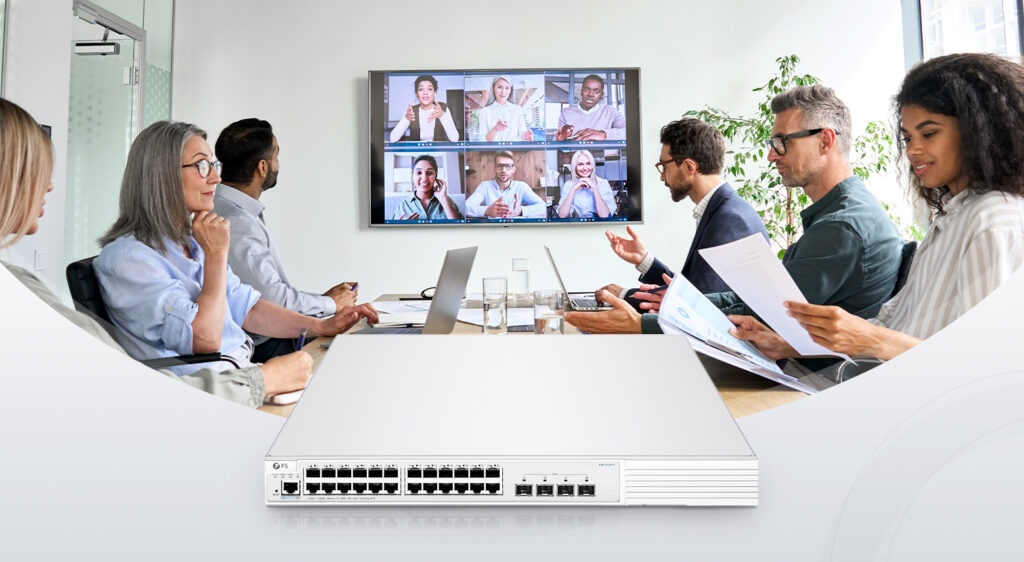With the ever-increasing need for swift data transmission, the 800G transceiver has garnered considerable interest for its attributes such as high bandwidth, rapid transmission rates, outstanding performance, compact design, and future-proof compatibility. In this article, we aim to provide an overview of the diverse range of 800G optical modules and delve into their applications to assist you in making an informed decision when selecting 800G transceivers.
Exploring the Range of 800G Transceivers
Based on the single-channel rate, 800G transceivers can be categorised into 100G and 200G variants. The diagram below illustrates the corresponding architectures. Single-channel 100G optical modules can be deployed more readily, whereas 200G optical modules demand more sophisticated optical devices and necessitate a gearbox for conversion. This section primarily focuses on single-channel 100G modules.

Single-Mode 800G Transceivers:
The 800G single-mode optical transceiver is suitable for long-distance optical fibre transmission and can cover a wider network range.
800G DR8, 800G PSM8 & 800G 2xDR4:
These three standards share similar internal architectures, featuring 8 Tx and 8 Rx, with a single-channel rate of 100 Gbps, and requiring 16 optical fibers.
The 800G DR8 optical module utilises 100G PAM4 and 8-channel single-mode parallel technology, enabling transmission distances of up to 500m through single-mode optical fibre. Primarily deployed in data centres, it serves 800G-800G, 800G-400G, and 800G-100G interconnections.
The 800G PSM8 makes use of CWDM technology with 8 optical channels, each capable of delivering 100Gbps. It supports a transmission distance of 100m, making it well-suited for long-distance transmission and efficient fibre resource sharing.

On the other hand, the 800G 2DR4 configuration denotes 2x “400G-DR4” interfaces. It features 2x MPO-12 connectors, allowing for the creation of 2 physically distinct 400G-DR4 links from each 800G transceiver without the need for optical breakout cables. As illustrated in the figure below, it can be connected to 400G DR4 transceivers and supports a transmission distance of 500m, facilitating smooth data centre upgrades.

800G 2FR4/2LR4/FR4/FR8:
FR and LR stand for Fixed Reach and Long Reach.
800G 2xFR4 and 800G 2xLR4 share similar internal structures. They operate with 4 wavelengths at a single-channel rate of 100 Gbps. Using Mux, they reduce the required optical fibres to 4, as depicted in the figure below. 800G 2xFR4 can transmit up to 2km, while 800G 2xLR4 supports distances of up to 10km. Both standards use dual CS or dual duplex LC interfaces for optical connectivity. They are suitable for various applications including 800G Ethernet, breakout 2x 400G FR4/LR4, data centres, and cloud networks.

800G FR4 follows a scheme that utilises four wavelengths and PAM4 technology, operating at a single-channel rate of 200 Gbps and requiring two optical fibres, as shown in the figure below. It supports a transmission distance of 2km and is generally used in data centre interconnection, high-performance computing, storage networks, etc.

Lastly, the 800G FR8 utilises eight wavelengths, with each operating at 100 Gbps, as illustrated in the figure below. It necessitates two optical fibres and can transmit up to 2km. Additionally, the 800G FR8 offers increased transmission capacity. Typical applications include wide-area networking, data centre interconnection, and more.

Multimode 800G Transceivers
In multimode applications with transmission distances under 100 meters, there are primarily two standards for 800G optical transceivers.
800G SR8
The 800G SR8 optical transceiver utilises VCSEL technology, offering advantages such as low power consumption, cost-effectiveness, and high reliability. With a wavelength of 850nm and a single-channel speed of 100Gbps PAM4, it requires 16 optical fibres, representing an enhanced version of the 400G SR4 with double the channels. Capable of achieving high-speed 800G data interconnection within 100m, it enhances data transmission efficiency in data centres. It employs either an MPO16 or Dual MPO-12 optical interface, as shown in the diagram. Typically used in various scenarios such as data centres, communication networks, and supercomputing, the 800G SR8 optical module is versatile and efficient.

800G SR4.2
800G SR4.2 optical transceiver employs two wavelengths, 850nm and 910nm, enabling bidirectional transmission over a single fibre, commonly known as bi-directional transmission. The module incorporates a DeMux component to separate the two wavelengths. With a single-channel rate of 100 Gbps PAM4, it requires 8 optical fibres, half the amount needed for SR8. The 800G SR4.2 makes use of a 4+4 fibre setup within an MPO-12 connector interface, offering a seamless transition from 400G to 800G without the need for alterations to the fibre infrastructure.

Unleashing Potential: Applications of 800G Transceiver
In the realm of high-performance networking, the evolution of 800G transceivers has ushered in a new era of possibilities. The high-speed, efficient, and reliable data transmission capabilities of 800G transceivers have led to their widespread adoption across multiple scenarios.
Data Center Connectivity
Data Center Interconnectivity is one of the primary domains where the prowess of 800G optical modules shines. With InfiniBand, these modules facilitate seamless communication between data centers, powering the backbone of modern interconnected infrastructures. The substantial increase in data processing capability and data transmission efficiency in data centres has been essential to meet the evolving demands of cloud computing and big data processing.
High-Performance Computing
In the arena of High-Performance Computing, where processing demands are ceaselessly escalating, the efficiency of 800G transceives becomes a game-changer. The modules ensure rapid data transfer, reducing latency, and optimizing overall system performance.
5G and Communication Networks
The surge of 5G and Communication Networks demands not only speed but also reliability. Enter the 800G QSFP and QSFP-dd transceivers, engineered to meet the demands of next-gen communication networks. Their advanced capabilities bolster the 5G architecture, ensuring a robust and responsive network infrastructure. The development has also fostered advancements in various fields such as the Internet of Things (IoT), Industrial Internet, and autonomous driving.
In the Metropolitan Area Network (Man) Domain
The metropolitan area network (MAN) serves as a bridge between local area networks (LANs) and wide area networks (WANs) across different locations, enabling high-speed data transmission between these locations through fibre optic networks. The high transmission rate of 800G optical modules can provide higher bandwidth and more stable connections, reducing data transmission delays between MANs. This improves data transfer rates and network responsiveness, fostering urban informatization and economic development.
Conclusion
800G optical transceivers, integral to the forthcoming high-speed optical communication era, come in diverse types catering to various application requirements. A comprehensive grasp of these types and their respective application domains, along with addressing common queries about 800G transceivers, will facilitate the advancement of data transmission technology. The mastery of this cutting-edge technology enables us to adeptly navigate the challenges and prospects presented by the digital era.
How FS can Help
FS offers a range of 800G transceivers to meet Ethernet and InfiniBand network connectivity needs. Additionally, FS’s overseas warehouses enable swift deliveries. Visit the FS website now for more product and solution information, and benefit from comprehensive service support.












-1024x506.jpg)
-1-1024x506.jpg)